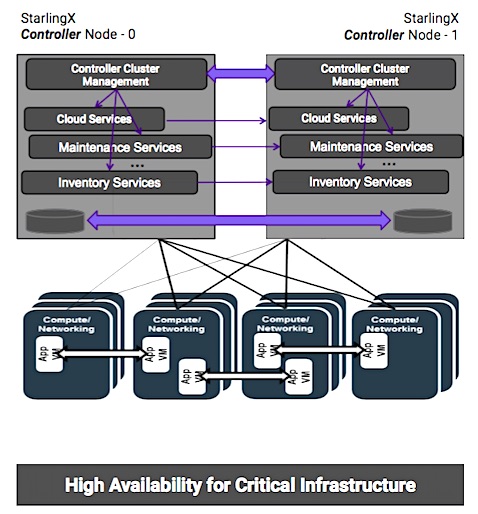Austin (TX), Starnberg, 15. Jan. 2020 - Erweiterte Open Source Edge-Computing und IoT-Cloud-Plattform mit Integration von OpenStack, Kubernetes and Ceph...
Zum Hintergrund: StarlingX - Open Source Edge-Computing und IoT-Cloud-Plattform - für Anwendungsprofile mit geringer Latenz und hoher Leistung optimiert, ist ab sofort in der Version 3.0 verfügbar. StarlingX adressiert nach Prognosen von 451 Research bis zum Jahr 2023 für OpenStack® und Kubernetes zusammen einen Markt von über 12 Milliarden US-Dollar. Die Plattform kombiniert die beiden Technologien mit Ceph, um eine container-basierte Infrastruktur für skalierbare Edge-Implementierungen bereitzustellen. Hier ein Auszug aus der Zusammenfassung der Ankündigung / Originalquelle (1):
Integrating OpenStack, Kubernetes and Ceph, StarlingX Expands Production Use Cases for Edge Computing and IoT Platform - Growing StarlingX Open Source Community Delivers 3.0 Release, Packed With Features For Cluster Monitoring, FPGAs and More. To further support the low-latency and distributed cloud requirements of edge computing and industrial IoT use cases, the community prioritized these features in StarlingX 3.0:
- Infrastructure and Cluster Monitoring
Version 3 introduces a new Armada manifest (stx-monitor) that defines the necessary software components and services to deploy a monitoring solution for the infrastructure and Kubernetes cluster as well as the services it is running.
- Integration with OpenStack Train
StarlingX is now based on the latest OpenStack release, Train.
- Integrate Distributed Clouds with Containers
Required changes are in place to integrate distributed clouds with containerized OpenStack.
- New Options for Hardware Accelerator Support
StarlingX now implements the initial Intel FPGA integration (via Darby Creek) into the platform. This support is in addition to other hardware accelerator support in StarlingX.
- Time Sensitive Networking (TSN) for VMs
TSN is a set of evolving standards developed by IEEE to allow for time-sensitive traffic on Ethernet-based LANs, which provides bounded, worst-case latency. It is a key technology that targets different segments such as automotive and industrial. TSN enabling on StarlingX is a major effort, since TSN is composed of multiple IEEE standards and varied use cases.
Since the project launched a year ago, there have been 5,928 commits from 187 authors. Today’s 3.0 release—just four months after the 2.0 release—adds 876 commits from 70 developers representing 99Cloud, FiberHome, Intel, the OpenStack Foundation, Red Hat and Wind River, among others. Users, operators and developers are invited to try out the software and engage with the StarlingX community on IRC (#starlingx on Freenode) and on the mailing list (lists.starlingx.io).

Abb. 1: StarlingX Project Overview, Service Management (Bildquelle: StarlingX Project Overview deck, page 13).
Link > Download StarlingX 3.0 at http://git.starlingx.io/starlingx
StarlingX Solves Problems at the Edge
The purpose of the StarlingX project is to re-configure proven cloud technologies for edge computing, delivering the maturity and robustness of cloud in a massively distributed compute environment. StarlingX is a complete edge cloud infrastructure platform for bare metal, VMs and containers, providing high availability (HA), quality of service (QoS), performance and low latency. StarlingX leverages components of other open source projects such as Ceph, Linux, KVM, OpenStack and Kubernetes, complementing them with new services such as configuration and fault management to collectively address the strict requirements of edge computing use cases in both carrier and industrial applications.
- StarlingX Applications Run the Gamut of Edge and IoT Use Cases
Use cases for StarlingX include transportation-based IoT applications; industrial automation; 5G; smart buildings and cities; autonomous vehicles; location-based retail; virtual radio access networks (vRAN); augmented and virtual reality; high-definition media content delivery; surveillance; healthcare imaging, diagnostics and monitoring; and universal customer premise equipment (uCPE).
- Meet the StarlingX Community at OpenDev + PTG in Vancouver
Members of the StarlingX community will gather at the next OSF collaborative open infrastructure event, OpenDev + PTG in Vancouver, June 8-11 for working sessions to map out the future of the project and collaboratively solve problems around deployment, operations, upgrades and more.
Community Comment:
“StarlingX 3.0 delivers some very exciting new capabilities. The StarlingX charter has always been to improve and simplify Day 1 and Day 2 operations for deploying workloads at the edge, and the 3.0 release takes some big steps towards that goal. StarlingX 3.0 includes a distributed cloud configuration that provides the foundation for geographically distributed edge use cases. StarlingX delivers single-pane-of-glass and zero-touch automated management for a distributed edge cloud, combined with ultra-low latencies for deterministic performance. These are critical capabilities for performance-sensitive edge use cases such as 5G vRAN, on-premise factory automation, and autonomous vehicles.” -Glenn Seiler, vice president of open source strategy, Wind River.
(1) Quelle: https://wiki.openstack.org/wiki/StarlingX/Releases
Querverweise:
